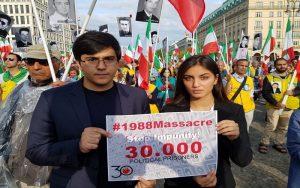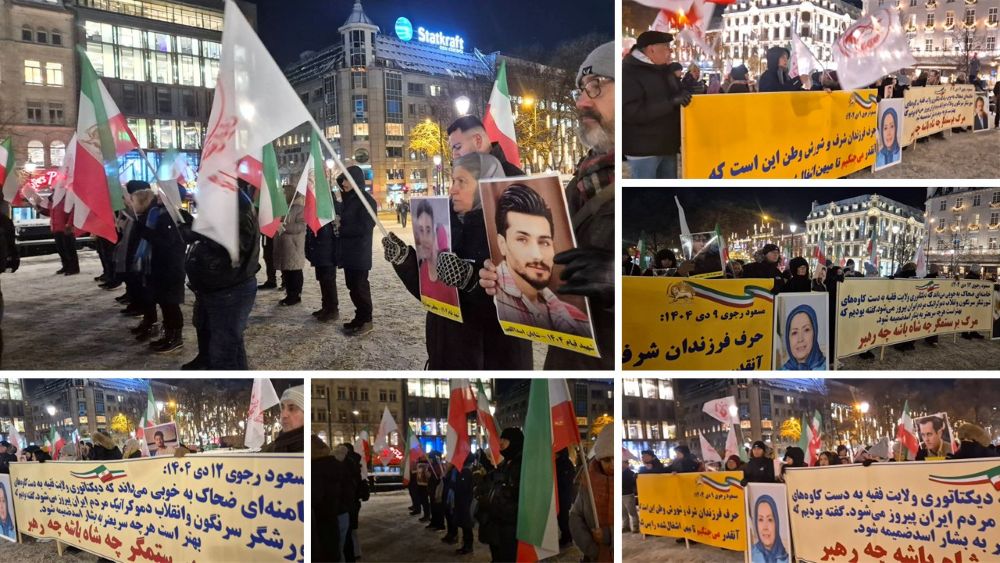What is the message of the gathering of Iranian communities at 30th anniversary of 1988 Massacre?
Iranian Opposition reflects the voice of Iranian communities at 30th anniversary of 1988 Massacre.
On Saturday, August 25, Iranian Communities held gatherings in 20 European capitals and major cities in Europe and North America. While expressing their support for the recent national uprising against the Mullahs regime, the participants demanded the trial of the perpetrators of 1988 Massacre.
30 years ago, Mullahs’ Regime in Iran executed more than 30,000 political prisoners based on Khomeini’s fatwa. The majority of the victims were members, supporters, and families of the PMOI/MEK.
These gatherings are just a part of the movement launched since two years ago under the leadership of Mrs. Maryam Rajavi, the leader of Iranian resistance. The movement known as the “Call for Justice” is aimed at bringing the perpetrators and the masterminds of the greatest massacre in the recent history to justice.
The “Call for Justice”; history:
In the hot summer of 2016, simultaneous with the entrance of the last groups of MEK members to Albania from Camp Liberty in Iraq, the Iranian resistance launched the “Call for Justice” campaign in regard with 1988 massacre.
A short while after, an audio file from Ayatollah Hossein Ali Montazeri (Khomeini’s successor ousted by him for protesting the massacre) was released protesting the “Death Commission”. Since then the “Call for Justice” has turned to a main issue in all political arenas regarding Iran.
In process, the 1988 Massacre became one of the main issues in the sham presidential election in Iran. Competitors accused each other of being engaged in the massacre of political prisoners in 1988.
The “Call for Justice” campaign resulted in the defeat of Ebrahim Raisi, a member of the “Death Commission” in the sham election. On the other hand, a number of prominent personalities across the world condemned the 1988 massacre of the political prisoners in Iran, in their statements. Specially, the late Ms. Asma Jahangir, the UN special rapporteur on human rights for Iran pointed to 1988 massacre in her statements and stances.
Maryam Rajavi’s speech at 30th anniversary of 1988 Massacre
https://iranfreedom.org/en/2018/08/27/massacre-political-prisoners-rajavi/
Iran Uprising:
A year and a half after the “Call for Justice” movement was launched, public protest demonstrations started in Iran. These demonstrations affected the mullahs’ regime situation so hard that, as Hassan Rouhani admitted, the tough position of president Trump against the ruling mullahs resulted from these anti-regime demonstrations.
Anti-regime demonstrations in Iran led to a new phenomenon, the resistance units; a number of freedom lovers who are fighting in the form of small teams from inside Iran to overthrow the religious fascism.
The resistance units enjoy a historical background of the struggle for freedom and the “Call for Justice” movement comes to their assistance by pushing for the trial of the 1988 massacre’s perpetrators. By playing a pivotal role in Iran’s uprising, these resistance units have enlightened the public opinion that the only way to gain justice is to overthrow the mullahs’ regime of Velayat-e-Faqih.
The Alternative:
No doubt, the Iranian opposition has various components inside and outside Iran, but we cannot disregard the role of the Iranian communities outside Iran, in Europe, US and etc, who are supporting the NCRI, the MEK, and the Iranian opposition in its entirety, anytime and anywhere. They represent Iranians’ struggle for a free Iran outside the borders.
https://iranfreedom.org/en/our-network/
The Iranian Communities have an effective and determinative role to connect the Iranian people inside Iran to the Iranian opposition. So many of these people have had no choice other than living in exile for decades but there are some who have left Iran during recent months. The Iranian Communities represent various categories of Iran’s society and represent Iranians of different ages and levels of education.

More important is the fact that they are that part of Iran’s society who have the possibility to speak of Mullahs regime’s lone democratic alternative, the NCRI, and the MEK, in the free world.
Nowadays, the surging activities of the Iranian communities abroad have attracted the attention of many observers. As various parameters are leading the Mullahs’ Regime towards its end, the supporters of the Iranian opposition showed their power vis-à-vis the Iranian Regime one more time. Their gathering was another sign of the tie between the “Call for Justice” movement, the resistance units and the NCRI as the alternative. The struggle still goes forward under the sagacious leadership of Mrs. Maryam Rajavi.



